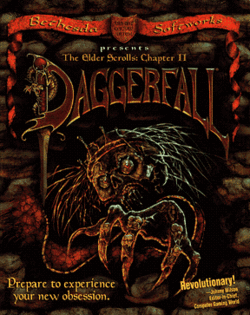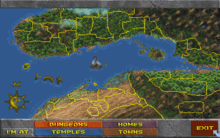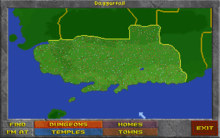The Elder Scrolls II: Daggerfall
| The Elder Scrolls II: Daggerfall | |
|---|---|
 | |
| Developer(s) | Bethesda Softworks |
| Publisher(s) | Bethesda Softworks |
| Director(s) | Julian Lefay |
| Designer(s) |
Julian Lefay Bruce Nesmith Ted Peterson |
| Programmer(s) |
Hal Bouma Julian Lefay |
| Composer(s) | Eric Heberling |
| Series | The Elder Scrolls |
| Engine | XnGine |
| Platform(s) | MS-DOS |
| Release date(s) | |
| Genre(s) | Action role-playing |
| Mode(s) | Single-player |
The Elder Scrolls II: Daggerfall is a fantasy open world action role-playing video game developed and published by Bethesda Softworks and released in 1996 for MS-DOS. It is a sequel to The Elder Scrolls: Arena and the second installment in The Elder Scrolls series. It is the first game in the series to be rated M. On July 9, 2009, Bethesda made Daggerfall available as a free, legal download on their website, commemorating the 15th anniversary of The Elder Scrolls franchise.[1]
Gameplay

In Daggerfall, as in all The Elder Scrolls games, players are not required to follow questlines or fill specific character types.
Daggerfall features a spell-creation system where, through the Mages Guild, players can create custom spells with several different effects. The game will then automatically generate the magicka cost of the spell based on the power of the effects chosen.
Other features include an equipment enchantment system (similar in concept to the spell creation system); the ability to buy houses and ships; a variety of clothing and equipment; dynamic political relationships between kingdoms; the ability to become a vampire, werewolf, or wereboar; and the combat system, which uses mouse movement to determine the direction and effect of weapon swings in melee combat.
The political system is supported by a net of guilds, orders, and religions, all with unique tasks and quests. Joining and contributing to these organizations allow the player to raise ranks and gain a reputation in the game world, which affects how NPCs and other factions view the player.
Daggerfall has genre-typical gore elements and some sexual topics. It displays cartoonish nudity including male and female genital areas when all equipment is removed. The game installer includes a password-protected childgard feature that hides blood and corpses (instead showing just the skeleton of the corpse), disables sexual topics (though not removing all nudity), and ensures the character portrait is wearing underwear at all times.
Daggerfall, like the other games in The Elder Scrolls series, takes place on the fictional continent of Tamriel. In Daggerfall, the player may travel within the High Rock and Hammerfell provinces of Tamriel. A wide range of formidable enemies, the strongest of which are the demonic Daedra, make the journey through these realms difficult.
Bethesda claims that the scale of the game is the size of Great Britain:[2] around 229,848 square kilometers (88,745 square miles), though the actual size of the map is 161,600 km² (62,394 mi²). Youtuber "How Big is the Map?" walked across the entire map from corner to corner. It took him 69 hours and 33 minutes. The game world features over 15,000 towns, cities, villages, and dungeons for the player's character to explore. According to Todd Howard, game director and executive producer for Bethesda, the game's sequel, The Elder Scrolls III: Morrowind, is 0.01% the size of Daggerfall, but some aspects of Daggerfall's terrain were randomly generated, like the wilderness and some building interiors. The explorable part of Morrowind, Vvardenfell, is 24 km² (9.3 mi²).[3][4] By comparison, The Elder Scrolls IV: Oblivion is approximately 56.97 km² (22 mi²),[5] and The Elder Scrolls V: Skyrim is 37.1 km² (14.3 mi²), with a quarter of this terrain as unplayable, as it is stuck behind invisible borders.[6]
In Daggerfall, there are 750,000+ non-player characters (NPCs) for the player to interact with, compared to the count of around 2,700 NPCs found in Morrowind and 1,000 in Oblivion and Skyrim. However, the geography and the characters in these later games are much more detailed.
An automap was implemented to help players navigate through the lengthy tombs and ancient underground fortresses. Players have to visit approximately 6-8 areas in order to finish the game, although a total of 47 areas are present. A limited array of building blocks were used to build the towns and dungeons, causing some reviewers to complain about the game's monotony. In 2002, Morrowind, the third game in the series, responded to this issue with a smaller, more detailed world containing unique-looking cities and NPCs with greater individuality.
Plot
Daggerfall is a city and kingdom in the Breton homeland of High Rock. The player is sent here at the personal request of the Emperor. He wants the player to do two things: First, the player must free the ghost of the late King Lysandus from his earthly shackles; Second, the player must discover what happened to a letter from the Emperor to a Blades spy in the court of Daggerfall. The letter reveals that Lysandus's mother, Nulfaga, knows the location of the Mantella, the key to resurrecting the first Numidium, a powerful iron golem. The emperor wants his spy to force Nulfaga into revealing the location of the Mantella so that the Blades can finish the reconstruction of the Numidium. Through a series of mishaps and confusions the letter fell into the hands of an orc by the name of Gortworg. Not knowing what the Mantella is, Gortworg consults Mannimarco, the King of Worms (the leader of the Necromancers). During this time the Underking, who originally destroyed the first Numidium because of its misuse by Tiber Septim, is recuperating deep within a tomb of High Rock after expending so much energy destroying it the first time. In order for the player to give the Mantella to anyone, the player must kill King Lysandus's murderer and put his ghost to rest. After accomplishing this, the player must steal the totem of Tiber Septim from King Gothryd of Daggerfall, and free the Mantella from its prison in Aetherius. Following this the player has six choices of how to deal with the Mantella.
Daggerfall has six endings:
- If the player activates the Mantella himself while in possession of the totem (the controlling device of the Numidium), the Numidium will slay the player, go out of control, and be destroyed by Imperial forces. Although this was listed as a possible ending on the Elder Scrolls official website during the 10th anniversary of the series, there doesn't appear to be any possible way to achieve this ending because the player cannot retrieve the Mantella without giving the totem to one of the major powers first. This ending is possibly just a rumor which even staff of Bethesda that did not work on the development of Daggerfall were led to believe was true. It is possible to achieve this ending through hacking of game files. However, the end result is unfinished and nearly unplayable due to bugs.
- If the player gives the Mantella to the Underking, he absorbs its power, passes into eternal rest, and creates a large "magicka free" area around himself.
- If Gortworg is victorious, he uses the Numidium to destroy the Imperial forces and the "Bay Kings", the rulers of the several provinces of the Iliac Bay. The Underking arrives shortly thereafter to destroy the first Numidium once and for all, losing his own life in the process. Gortworg then succeeds in creating Orsinium, a kingdom of Orcs.
- If the Blades are victorious, they succeed in recreating the first Numidium and use it to defeat the Bay Kings and the Orcs as well as unite all the provinces of Tamriel under the empire once again.
- If any of the Bay Kings win, that king will use the first Numidium to defeat all the other kings just before the Underking destroys him and itself.
- If Mannimarco receives the Mantella, he uses it to make himself a god.
Development


Design goals
Work on The Elder Scrolls II: Daggerfall began immediately after Arena's release in March 1994.[7] The new project saw Ted Peterson assigned the role of lead game designer.[8] Originally titled Mournhold and set in Morrowind, the game was eventually relocated to the provinces of High Rock and Hammerfell, in Tamriel's northwest.
With Daggerfall, Arena's experience-point based system was replaced with one that rewarded the player for actually role-playing their character.[7] Daggerfall came equipped with an improved character generation engine, one that included not only Arena's basic class choices, but also a GURPS-influenced class creation system, offering players the chance to create their own classes, and assign their own skills.[8][9]
Daggerfall was initially developed with an updated 2.5D raycast engine, like Doom's, but it was eventually dropped in favor of XnGine, one of the first truly 3D engines. Daggerfall realized a gameworld of 160,000 square km,[7] filled with 15,000 towns and a population of 750,000.[10]
Influences
Daggerfall, in Peterson's opinion, was little-influenced by contemporary video games, as they simply "weren't very interesting." "I can remember playing the latest King's Quest, Doom, and Sam and Max Hit the Road while working on it, but I can't say they had any profound impact on the story or design." Daggerfall's most profound influences came from whatever analog games and literature Julian LeFay or Ted Peterson happened to be playing or reading at the time, such as Dumas's The Man in the Iron Mask, which influenced "the quest where the player had to find the missing Prince of Sentinel," and Vampire: The Masquerade, which influenced "the idea of vampire tribes throughout the region."[8]
Release
Daggerfall was released on August 31, 1996,[11] within the game's intended release window.[12] Like that of Arena, Daggerfall's release suffered from buggy code. It was patchable code, however, a fact that nonetheless left consumers disgruntled.[13] The yearning to avoid what were, in LeFay's words, "all the stupid patches we had for Daggerfall" led to a more cautious release schedule in the future.[14] Ted Peterson left Bethesda following Daggerfall's release and went to work for a series of companies in Los Angeles and San Francisco: Film Roman, AnyRiver Entertainment, Activision, and Savage Entertainment.[8]
Community support
After the end of official support by Bethesda, some mod makers have repaired bugs in the latest official release of Daggerfall with community patches. The DFQFIX quest-fix pack and HackFall were the most recent attempts at this.[15][16]
DaggerfallSetup is a community-made Daggerfall installer for modern Windows versions.[17] The aim of this project is to install and easily run a fully patched Daggerfall on a modern Windows operating system under usage of the DOSBox emulator. This game installer setup contains many official and unofficial patches and also fan translations for several languages, including French, Russian, Spanish, and German.
Engine remakes
There are also fan-made game engine rewrite projects for Daggerfall, which aim for native compatibility with modern operating systems and hardware (as opposed to being run in DOS, or through DOSBox[18]). The XL Engine[19] was started in June 2009 named DaggerXL and merged in 2011 with another engine rewrite project to the XL Engine. The final goal of the XL Engine is the support of many classical 3D game engines.[20] Additional goals – for Daggerfall specifically – include the implementation of features that were initially promised for the game, but were not included (or only partially coded in) at the time of its release in 1996. As of August 2012, DaggerXL supports character creation, the rendering of all provinces and dungeons, user-definable display resolution (including smoothed terrain and Bloom), and basic gameplay. While additional gameplay features and bug fixes are being implemented for DaggerXL, a significant amount of the project's development since 2011 has involved the refactoring of the XL Engine itself as a result of the merger.
Daggerfall Unity is another open source recreation of The Elder Scrolls II: Daggerfall using the Unity game engine with active development as of September 2016.[21]
Modding
Although Daggerfall did not come with official modding tools like later The Elder Scrolls releases, enthusiasts for the game developed tools on their own to access the game's content soon after its release. As a result, a number of additional quests, graphical enhancements, and gameplay features were developed by third parties. Notable works include AndyFall[22] and DaedraFall.[23]
Reception
In 1996, Computer Gaming World ranked it as the eighth top vaporware title in computer game history (due 1994, delivered 1996), stating "Featuritis and creeping technology held up this potential jewel for far too long."[24]
References
- ↑ Thompson, Michael (2009-07-10). "Bethesda releasing Daggerfall for free". Arstechnica.com. Retrieved 2011-12-02.
- ↑ "Bethesda Softworks". Bethsoft.com. Retrieved 2013-10-27.
- ↑ CDA Access
- ↑ Ace Gamez
- ↑ Firing Squad
- ↑ How large is Skyrim?
- 1 2 3 "Daggerfall – Behind the Scenes". The Elder Scrolls 10th Anniversary. Bethesda Softworks. 2004. Archived from the original on 7 Apr 2004. Retrieved 2007-06-09.
- 1 2 3 4 "Ted Peterson Interview I". Morrowind Italia. 2001-04-09. Retrieved 2007-06-08.
- ↑ "Daggerfall". Next Generation Magazine (11): 82–5. November 1995.
- ↑ Blancato, Joe (2007-02-06). "Bethesda: The Right Direction". The Escapist. Retrieved 2007-06-01.
- ↑ "Daggerfall release dates". GameSpot. Retrieved 2007-07-09.
- ↑ Ward, Trent C. (1996-05-01). "Daggerfall Preview". GameSpot. Retrieved 2007-06-14.
- ↑ Barton, Matt (2007-04-11). "The History of Computer Role-Playing Games Part III: The Platinum and Modern Ages (1994–2004)". Gamasutra. Retrieved 2007-06-08.
- ↑ "Battlespire". Next Generation Magazine (34): 124–5. October 1997.
- ↑ "DFQFIX". UESPWiki. Retrieved 2010-02-28.
- ↑ "HackFall". Daggerfall Tool Repository. slushpool.dfworkshop.net. Retrieved 2012-08-05.
- ↑ "DaggerfallSetup". Homepage. Retrieved 2013-10-04.
- ↑ How to Play Daggerfall on Your Windows 7 PC on PCWorld (2011)
- ↑ Smith, Adam (2011-11-18). "Mods And Ends: Daggerfall & The XL Engine". Rock, Paper, Shotgun. Retrieved 2013-10-04.
[XL Engine] [...] it's a custom-built framework to run old games. Essentially, it totally overhauls them, with all sorts of visual enhancements and improved modding support, so it's almost as if they are being ported onto modern systems.
- ↑ "DaggerXL". Homepage. Retrieved 2011-05-06.
- ↑ "DaggerFallUnity". Homepage. Retrieved 2015-09-11.
- ↑ "AndyFall". UESPWiki. Retrieved 2010-02-28.
- ↑ "DeadraFall". UESPWiki. Retrieved 2010-02-28.
- ↑ CGW 148 The 15 Vaporware Title in Computer Game History